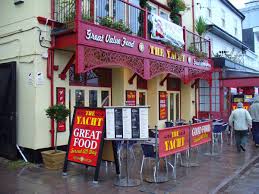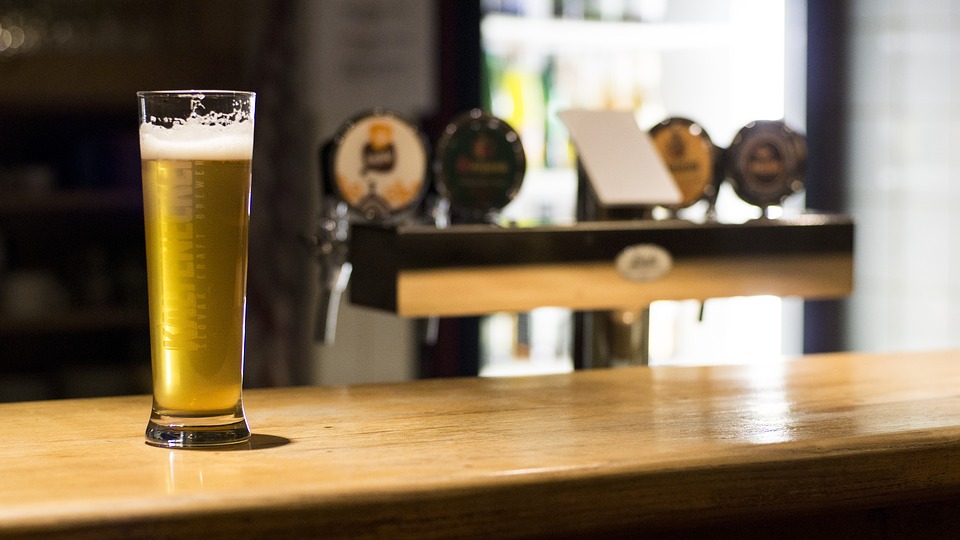
The great Torquay pub was never just a place to drink. It was a social centre, the focus of community life and a launch pad for local musicians.

The first record we have of our imbibing history comes in 1774 when an Exeter printer by the name of Andrew Brice wrote in his Grand Gazetteer that, “at Tor Kay is a village and an inn or two”. Actually, there were five “houses of entertainment” on Torquay harbourside servicing a population of around 500. They were licensed “for man and beast”, and included ‘The Bird in the Hand’ whose landlady, Betty Cole, was noted as never giving credit. The motto on the inn’s hanging sign stated: “A bird in the hand is better far, than two birds in the bushes are.” ‘The Bird in the Hand’ became the ‘London Inn’ and then ‘Wolfinden’s London Inn’ in 1840, and eventually the ‘Royal Hotel’. It’s now back on around the same site as the original ‘London Inn’, using the same name and run by Wetherspoons.

Another harbourside venue was ‘The Crown & Anchor’ situated on the site of 6 & 7 Victoria Parade. In 1844 it changed to ‘The Steam Packet’ and burned down soon after. ‘The Old Inn’, in Torwood St became ‘The Commercial Hotel’, and later ‘Gibbons’ Commercial Hotel’, and is now ‘Park Lane’.

‘The Marine Tavern’ was a one-storey pub situated in front of the Pavilion. Here’s an example of where a pub can attract a specific clientele as, during the 1970s, the ‘Tavern’ became well known throughout the country as a bikers’ pub, with one bar being advertised as ‘strictly bikers only’. The pub was a shrine to biking with well-known biker Max (the Axe) as a barman, and it featured a prominent sign saying: “No Junkies Drunks Served”. ‘The Marine Tavern’ was demolished in September 1988.

‘The Shallop’ eventually became the (in)famous ‘Yacht’. A report in the early 1970s relates that, “It’s the height of the summer season in Torquay and lads from all over Britain are bevying it up in the long dark music bar. The girls are with them, indistinguishable with their long hair hanging over sweat shirts and faded jeans.” Pubs were often run by landlords who acquired a personal reputation that went along with their premises – the ‘Yacht’ being run by Ernie Garnham who managed a venue with a reputation for rowdiness. You certainly had to be fairly tough to run a Torquay harbourside pub. Ernie stated at the time, “This pub is one of the best known in Britain. People from Blackburn or Bradford, Leeds or Glasgow say ‘see you in the Yacht’ when they move south. And they do.” Ernie’s wife Paula remembered the violence, “The first year was the worst. There was one fight where all Ernie had left on was his pants and a collar. He just come to me and said ‘Get me another shirt, Love’.”

A few yards away from the clock tower stands ‘The Hole in the Wall’ which has been going strong since 1540 – but not as a pub. This leads into a debate over which are the oldest pubs in Torquay. ‘The Hole in the Wall’ is certainly the oldest building. We may, however, need to go to the other end of town for the oldest (almost) continuous-use pub. In 1837 the Court Book of the Manor of Torwood recorded that seven houses were to be built in the ‘orchards, furze and grass plots’ on Lower Commercial Road – later to be renamed Lower Union Street. At the same time as the houses were built, Joseph Reed opened the Castle Inn in Binney’s Orchard. By 1974 it was described as, “The most valuable public house in south Devon”.

Each Torquay pub was different, reflecting its premises, location, clientele and landlord or landlady, and its reason for being. For instance, another old pub had its origins during the age of the stagecoach. Up until 1982, the Printers Elbow II in Higher Union Street used to be ‘The Globe’. It had been by this title since 1833 when it converted from a private house. It was a coaching house and the last stop in Torquay for Royal Mail coaches on their way to Exmouth and London.
By the mid-nineteenth century there were a wide variety of drinking establishments available for Torquay’s much increased population of 11,400. White’s Directory of 1850 gives a list:
Apsley House, Park Hill
The Castle Inn, Lower Union Street
The Commercial Inn, Market Street
The Exeter Inn, Lower Union Street
The Globe, Higher Union Street
The Golden Lion, Lower Union Street
The Half-Moon, Lower Union Street
Hearder’s Hotel, Victoria Parade
The King William, Madrepore Place
The London Hotel, Fleet Street
The Marine Inn, Palk Street
The Market Inn, Lower Union Street
The Maritime Inn, Victoria Parade
The Rising Sun, South Street
The Royal Hotel, The Strand
The Star, Higher Union Street
The Steam Packet, Victoria Parade
The Torbay Inn, Tor Square
The White Hart, Lower Union Street
The White Swan, Swan Street
In addition to these often better-quality venues there were many Beer Houses. These were established with the optimistic aim of “reducing public drunkenness”, the Beer Act of 1830 having introduced a new lower tier of premises permitted to sell alcohol. At the time beer was viewed as harmless, nutritious and even healthy – local water was often unsafe and ale was at least less damaging than gin. Torquay’s Beer Houses were in:
Braddon’s Row (which had 2)
Brunswick Place
Church Lane (2)
George Street
Grill Road
Higher Union Street (3)
Lower Union Street (3)
Madeira Place (2)
Madrepore Place
Melville Street (2)
Meadfoot Row
Park Lane
Pimlico (2)
South Street (2)
Temperance Street (2)
Tor
Torwood Row
Waldon Terrace
We all know that the numbers of establishments have been in decline for many years. Nationally there were 99,000 pubs in 1905 but just 77,500 by 1935. In 1969, there were 75,000, falling to 69,000 by 1980. Some of the first to go were the victims of town centre redevelopment and the rise of the major shopping outlets. ‘The Prince of Wales’ in Union Street closed in September 1961. Along with many other Torquay pubs, it was used by US and Canadian servicemen during the War. The day it closed, the licensee Mrs Harriet Steer said: “People’s drinking habits change with the times. Years ago, when a pint of beer was four pence and a pint of bitter sixpence, men used to come in their work clothes. Now they go home first, wash and change and arrive clean and fresh. Saturday nights, when the shops used to stay open until late, Union Street used to look like a fair. People from the country used to come up to shop. There were fruit barrows up the roads and meat was auctioned.” The Prince of Wales was demolished to make way for a Marks & Spencers. The site is now occupied by ‘Primani’.

Pubs were often long-standing business and the focus of community life. For example, Melville Street’s ‘Coburg Inn’ was operated by the Howis family for 150 years and first built as a stables, coach house, saddlers and a grocery store. After taking ladies and gentlemen to church on Sunday mornings, the coachmen would return to the ‘Coburg’ where the bar was lined up with foaming beer tankards. The inn was noted for having “a magnificently executed coat of arms” associated with the European dynasty of Saxe-Coburg-Gotha. ‘The Coburg’ closed in 1971.
Another pub with a fraternity of co-workers was ‘The Post Horn’, on Madrepore Rd. Due to its location, just off what used to be called the GPO Roundabout, it was once a favourite of Torquay’s postmen. There used to be a tradition across the country where ex-professional footballers ran pubs – during the 1980s, the landlord was John Sims of Exeter City and Torquay United.

It isn’t just today that changes in entertainment habits have affected pubs. ‘Ryan’s Bar’ – off Abbey Road – used to be ‘The Old London Inn’. The only entrance was half way up the steps opposite the Gallery entrance of the Theatre Royal. As the Inn counted among its patrons the audience, actors and staff of the theatre, when the building changed into a cinema in 1933 a great deal of trade was lost. As is the case today, pubs had to quickly adapt and soon the pub catered for other customers. By the later 1930s, “Our customers consisted mainly of working men, some of whom came in still dressed in their corduroy trousers with leather straps around the knees, straight from digging the roads by pick and shovel… Occasionally an American warship would come into the Bay and their sailors, coming from Prohibition in the States, soon got very drunk and it was a common sight to see their naval police collecting up the drunks and literally throwing them into the boats in the inner harbour”.
Location and our eccentric drinking laws could cause celebrations to occur at odd times. In 2000 pubs were finally allowed to legally open from 11 am through to 11 pm. Before that pubs had to close after lunch causing some drinkers to pack as much beer in to a few hours. For instance, the ‘Cider Press’ was well known as having a wild Sunday lunch time session as holiday-makers and locals joined together before the visitors – often hen or stag parties – caught their coaches’ home.

As the focus of community life Torquay’s pubs have witnessed pivotal moments of social change as new fashions, music and attitudes were discussed over a beer. Sometimes new lifestyles clashed with traditional behaviour. At 9.30pm on April 12, 1969 around 70 members of the Torbay Drugs Squad raided Belgrave Road’s ‘Rising Sun’, now ‘DTs’, with a warrant to search anyone. Some 17 local hippies were arrested – 16 for possession under the Dangerous Drugs Act and one for wilfully obstructing Police Constable James Copeland. This was the first raid of its kind in Torbay and an indication of how sedate Torquay had joined the youth rebellions of the sixties.
As we can all see as we drive around our town, the decline of the pub trade has continued. Nationally, there were still 58,200 public houses in 2006 but just 48,000 today – 29 pubs a week are being lost. Home entertainment, health concerns, the smoking ban and competition from supermarkets and the new corporate bars have all eroded the traditional pub. So, if you want to preserve a unique experience, support your local public house.


























